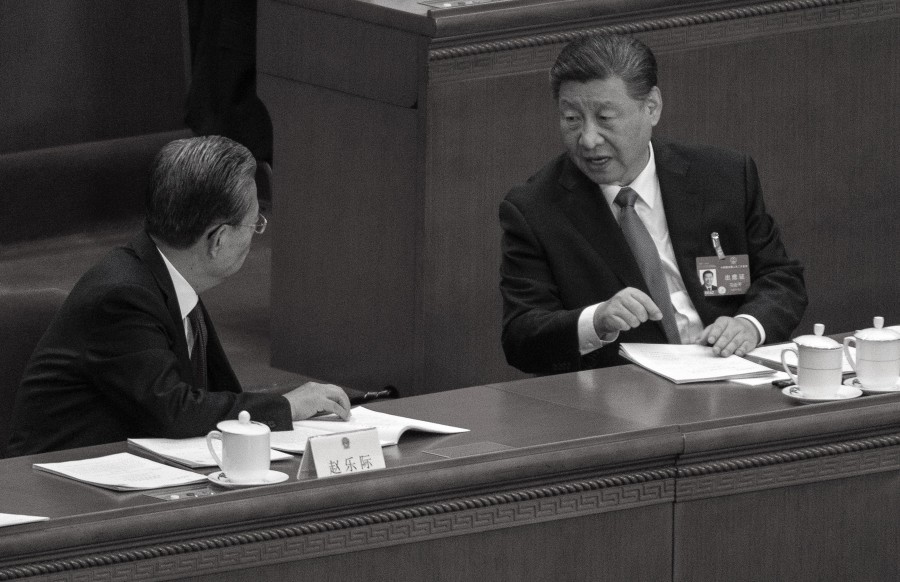[People News] On October 30, U.S. President Donald Trump and Chinese Communist Party (CCP) leader Xi Jinping met at the U.S. military base in Busan, South Korea.
From American live-broadcast footage, Xi appeared noticeably less natural and relaxed than he had been in their two meetings in 2017. Throughout, Trump did most of the talking, while Xi spoke very little, giving an impression of stiffness. During the formal talks, Xi read from his notes far more often than before, unlike 2017 when he could speak extemporaneously. If Xi’s memory has declined because of illness, that would make sense.
The “Trump–Xi Meeting” ended after just over an hour with no joint press conference or communiqué—reportedly because Trump was eager to return to the White House for a party. Since representatives from both sides had already reached a trade understanding in Kuala Lumpur beforehand and Beijing had proactively placed soybean orders to please Trump, little time was needed to confirm results.
From what Trump told reporters aboard Air Force One on his flight home, several key points were settled:
-
China pledged to immediately purchase an “enormous” quantity of U.S. soybeans; Xi had authorized large-scale buying the previous day.
-
All barriers to rare-earth exports were removed; the 100 percent tariffs the U.S. had scheduled for November 1 were canceled.
-
They discussed semiconductor issues. China may buy U.S. chips, but the talks excluded the newly released high-end Blackwell series—even the downgraded versions.
-
Xi agreed to work “very hard” to curb fentanyl and precursor smuggling; in return, the U.S. cut its 20 percent punitive tariffs to 10 percent. Still, original Section 301 and 232 tariffs remain—U.S. tariffs drop only from 57 to 47 percent.
-
They spent much time on the Ukraine war and will try jointly to end it.
-
Both sides will arrange high-level visits: Trump to China next April, Xi to the U.S. afterward.
-
Taiwan was not discussed.
Trump’s detailed “deliverables” show that under U.S. pressure—and after Trump’s successes with Australia, Japan, and Southeast Asia in building a rare-earth supply chain—Beijing’s leverage had collapsed. Cornered, the CCP chose to bow: making concessions on soybeans, fentanyl, and rare-earths, thus wrapping up Trump’s five-day Asia trip on a high note.
Beijing, however, did not want the Chinese public to know the truth, so its propaganda carefully doctored the narrative.
Where Trump spoke substantively before reporters, Chinese state media had Xi mouthing grandiose clichés:
“Facing winds and waves, the two heads of state, as helmsmen, must keep direction and steer the big ship of China–U.S. relations steadily forward,”and“Both sides should take the long view of cooperation’s benefits instead of falling into a vicious cycle of retaliation.”
The goal of such fine-sounding but hollow lines is twofold: to show China as America’s equal and to suggest China’s supposed responsibility and magnanimity—implying the U.S. is the obstinate side. But Americans, long burned by the CCP’s lies, no longer believe such rhetoric. Even the CCP doesn’t believe itself; lying is its nature. These phrases are meant to lull the U.S. while it pursues its aim of undermining America and the world. Yet today’s U.S. has learned to “listen to words but watch deeds”—and when talk fails, to use power, as it did this time to make Beijing yield. Thus the flowery lines merely fool a domestic audience unaware of the facts.
Beijing also played a subtle visual trick. Among four photos released by Xinhua, the second purposely shows Trump a split-second before shaking Xi’s hand, his head slightly lowered and eyes looking down, while Xi stares straight at him. Seen alone, some Chinese might cheer, “Trump bowed! We prevailed!”—a sly act of self-delusion.
Notably, state media omitted mention of Ukraine or chip-export issues, likely to keep citizens ignorant of those talks.
A Commerce Ministry press briefing the same day revealed how Beijing inverted causality in describing the Kuala Lumpur trade consensus.
In reality, because Xi promised to curb fentanyl smuggling, the U.S. lifted its 10 percent fentanyl-related tariff. Yet the spokesperson skipped the cause and said only:
“The U.S. will remove the 10 percent fentanyl tariff on Chinese goods, and extend suspension of the 24 percent reciprocal tariff for one year; China will correspondingly adjust its counter-measures.”
Likewise, it was China’s agreement to lift rare-earth export limits and increase soybean purchases that prompted Washington to suspend—for one year—the “50 percent penetration-rule” export control and the 301 maritime/logistics/shipbuilding probe. But the CCP flipped the sequence.
By separating these topics from U.S. sanction relief and stating blandly that “both sides reached consensus on fentanyl cooperation, agricultural trade expansion, and corporate cases,” Beijing staged a self-congratulatory narrative—because it feared people might realize it was the CCP, not Trump, who had knelt.
Can a grudging CCP truly honor its promises? Given its notorious record, Trump and his team surely doubt it; hence they granted only a one-year trial period.
What twists will unfold within that year? Time will tell.











News magazine bootstrap themes!
I like this themes, fast loading and look profesional
Thank you Carlos!
You're welcome!
Please support me with give positive rating!
Yes Sure!